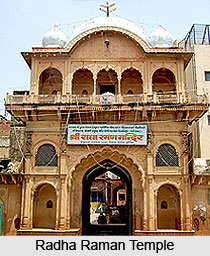 Sri Radha Raman Temple, an ancient Vaishvite temple, is located in Vrindavan in the Indian state of Uttar Pradesh. The presiding deity of the temple, Lord Krishna, is referred to as Radha Ramana meaning the lover (ramana) of Radha.
Sri Radha Raman Temple, an ancient Vaishvite temple, is located in Vrindavan in the Indian state of Uttar Pradesh. The presiding deity of the temple, Lord Krishna, is referred to as Radha Ramana meaning the lover (ramana) of Radha.
History of Radha Raman Temple
Radha Raman Temple, dating back to almost 500 years, was built in 1542 by Gopala Bhatta Goswami when he came to Vrindavana at the age of thirty. The temple stands as one of the constructed and venerated pilgrimage centres of Vrindavan principally by the Gaudiya Vaishnavism also known as Goswamis. The temple even today enshrines the original saligram idol of Krishna installed by the side of Radharani.
After the departure of Chaitanya Mahaprabhu Gopala Bhatta Gosvami felt being separated from the Lord. To alleviate his devotee from grief, the Lord appeared in his dream and instructed him to visit Nepal to have his darsan. As instructed he went to Nepal and bathed in the famous Kali-Gandaki River. As he dipped into the holy waters to his surprise he saw several Saligrama Silas entering his pot. He then dropped them back into the river but the silas again entered into the pot when he filled it with water.
Gopala Bhatta Gosvami overall found twelve Shaligrama shilas. It is said that once a wealthy man visited Vrindavana and gave Gopala Bhatta a variety of clothes and ornaments to adorn the Shaligrams. One day during a Purnima evening Gopala Bhatta Gosvami upon worshipping his Shalagram shilas, put them to rest and covered them with a wicker basket. Next day in the early morning he took bath in the holy waters of Yamuna River. After returning when he uncovered the Shaligramas to offer them the puja he saw amongst them an idol of Lord Krishna playing a flute. The "Damodara shila" had manifested itself as the beautiful three-fold bending form of tri-bhangananda-krishna. The image thus emerged into the sacred fossilized salagrama stone. Devotees visiting the temple regard the image to be alive granting their wishes and showering their blessings on them.
The daily Prasad of Shri Radha Raman Ji is prepared by the male members of the Goswami families in the kitchan of the Mandir. Within the premises of the temple the samadhi of Gopal Bhat Goswami Ji sathal can be seen. The Unag vastar of Shri Chaitanya Mahaprabhu is also kept there.











